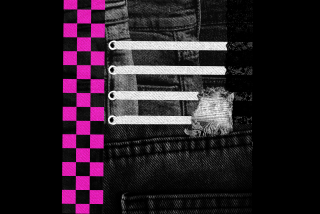Most Muslim Girls Comply With France’s New Head Scarf Ban
SAINT-OUEN, France — The first day of school is never easy. But the start of classes Thursday was especially tough for French Muslim mothers such as Nissia.
As a new ban on Islamic head scarves in public schools took effect, Nissia, a short, slim woman who speaks French with an Arabic accent, reluctantly decided to let her teenage daughter comply with the law.
Devout Muslims such as Nissia and her daughters, a high-schooler and a college student, are a familiar sight in the gray landscape of factories and high-rise housing projects on the northern edge of Paris. Nissia wears a black head scarf and a full robe. Her daughters combine colorful head scarves with jeans and gym shoes.
Nonetheless, Nissia said she did not want to jeopardize her younger daughter’s education. Moreover, with militants in Iraq threatening to kill two French hostages if the ban was not repealed, even staunch critics were professing loyalty to France, first and foremost.
Wearing the head scarf “is an Islamic law,” said Nissia, who declined to give her full name when she was interviewed with her children at a subway stop near Lycee Blanqui, a high school in this working-class suburb. “Since we have chosen to be observant, we observe everything. But we respect the law of the French state. We are against it because it forbids wearing the head scarf, but we respect it.”
Despite fears of clashes -- police were stationed at school gates -- the restrained mood nationwide showed how the hostage crisis had remarkably, if temporarily, unified a society struggling to integrate its Muslim population.
The government said it would strictly enforce the new law, which bans prominent religious symbols and which officials say is intended to shield France’s secular traditions from rising Islamic extremism. Authorities said 240 schoolgirls showed up in head scarves Thursday, compared with 1,200 last year. Seventy refused to remove them but were allowed inside; educators said they would talk to parents before taking disciplinary action.
Although French leaders say the ban is needed to protect the liberty of Muslim girls from extremists, some people expressed resentment mixed with resignation outside Lycee Blanqui and other schools.
Saint-Ouen sits just north of the Peripherique, the highway encircling Paris that separates the capital’s guidebook grandeur from the growing immigrant-dominated industrial suburbs. The school is near a commercial strip where French mixes with Arabic outside an automotive shop, a telephone center offering discount foreign calls, and a boutique selling traditional African garments.
At the subway stop Thursday, Nissia’s elder daughter, Naciba, spoke for her teenage sister, who did not give her name. The shy, bespectacled high-schooler had barrettes in her hair and seemed overwhelmed by the day’s events.
Naciba was disappointed that school officials seemed resistant to compromises such as partial head coverings, which had been recommended by Islamic activists in recent days.
“There are some teachers who won’t even accept a bandanna,” Naciba said. “I don’t see how that affects them.”
Outside the school, a 19-year-old of African origin said she for years had contemplated wearing a head scarf, but decided against it this year because of the controversy.
“I don’t come to school with the head scarf, but I’d like to,” said Fatou, who had on jewelry and a sleeveless blouse. “I don’t understand why it bothers anyone why a girl wears it or doesn’t wear it. We all learn the same thing!”
The scene around her was repeated across France. Muslim girls walked out of school, put their head scarves back on and hurried to waiting cars or families, all but fleeing waiting journalists. Several women said imams and community groups had urged students and parents to avoid conflict and refrain from public statements that could be detrimental to the safety of the hostages and the image of French Muslims.
“Our work has been to explain to girls that the law is not an attack on them and that they should try to find a compromise,” said Nora Jaballa, who heads a women’s group affiliated with the Union of Islamic Organizations of France, a conservative group that has moderated its tone recently. “It’s very difficult to choose between your education and your spirituality. But this hostage-taking does not serve our cause. We are against it. We have condemned it repeatedly.”
President Jacques Chirac proposed the law, on the recommendation of a special commission he convened last year that documented the rise of Islamic extremism in schools and other public institutions. The panel heard testimony about Muslims using fraudulent medical excuses for girls to avoid gym and swimming classes, refusing to study biology or the Holocaust, assaulting Jewish students, and rejecting the authority of female teachers and principals.
Intelligence officials say the use of head scarves, veils and burkas in France’s Islamic community has soared in the last five years. Advocates of the ban say many girls are forced to wear the head scarves by a new, French-born generation of extremists in their 20s and 30s who regard such coverings as banners of faith.
“It’s the political uniform of the extreme Muslim right,” said Bernard Teper, president of the 7,000-member Union of Secular Families. “I think there’s a difference between a girl of 12 who wears a head scarf and a young woman of 25 who wears it of her own free will.”
France’s 5 million Muslims, Europe’s largest Islamic community, make up about 8% of the population. But Muslims dominate many urban school districts because of demographic trends that could result in their accounting for nearly 50% of the French population by mid-century, according to some projections.
Claire Rocher of The Times’ Paris Bureau contributed to this report.
More to Read
Sign up for Essential California
The most important California stories and recommendations in your inbox every morning.
You may occasionally receive promotional content from the Los Angeles Times.










